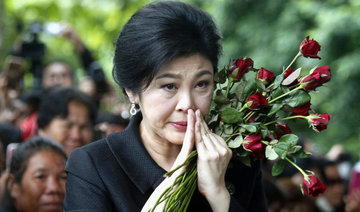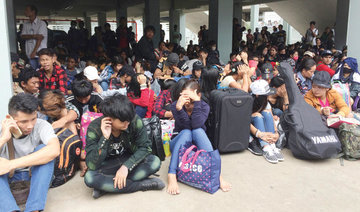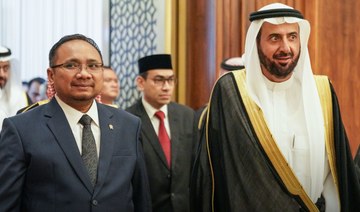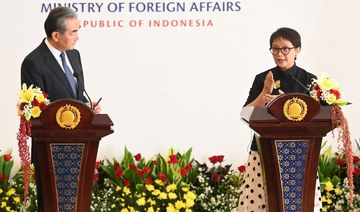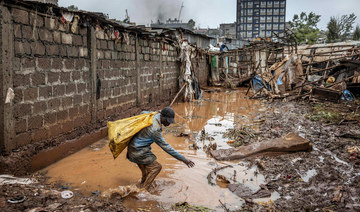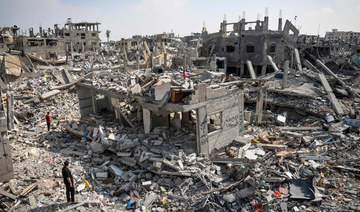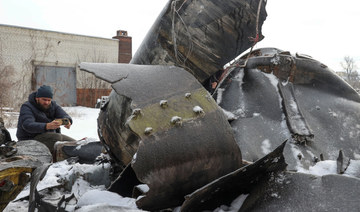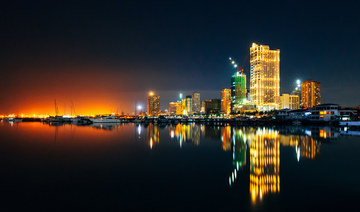BANGKOK: Anti-government protesters began marching in Bangkok on Tuesday from a university in the Thai capital to Government House to demand that the military government hold a general election by November.
Government House and surrounding streets have been declared a no-go zone by police for the opposition march marking four years since a May 22, 2014, coup and have warned protesters not to defy a junta ban on public gatherings.
Police set up barriers along some roads near the university and carried out security checks on Tuesday.
More than 100 demonstrators walked in a line behind a truck with loudspeakers as police looked on, according to Reuters reporters at the scene.
One of the protest organizers, Sirawith Seritiwat, also known as Ja New, said protesters planned to march peacefully.
“I hope they will let us walk out. We have no intention to prolong today’s activities. I think they will try to stop us ... we will not use violence,” Sirawith said.
Police said around 200 protesters had gathered.
“Authorities will use the law 100 percent. If they walk out we will use the law immediately. We have put forces all around Government House ... if they come in to these areas there will be a prison sentence of up to 6 months,” deputy national police chief Srivara Ransibrahmanakul told reporters.
“Police have no weapons. They are carrying only batons,” he said.
Activists complained of a military crackdown ahead of the gathering.
On Monday, Sunai Phasuk, Thai researcher at the New York-based Human Rights Watch group, said two activists had been held incommunicado at a secret detention center.
“Their alleged ‘crime’ is providing loud speakers for anti-junta rally,” Sunai wrote on Twitter.
They were later released.
The junta, known as the National Council for Peace and Order, is facing a public perception crisis, according to international and domestic polls that say corruption is as endemic as ever.
The government has also repeatedly delayed the general election, which was first tentatively set for 2015, with the latest date now February 2019.
Some fear the date could be pushed back again.
Deputy Prime Minister Prawit Wongsuwan told reporters gathered at Government House the protesters were welcome to send a representative to the prime minister’s office.
“The prime minister works hard ... the NCPO these four years has worked every day ... All NCPO members have worked hard,” Prawit said.
Suchada Saebae, 55, a market vendor, disagreed.
“I came since 6 a.m. this morning because I think the NCPO has done a rubbish job these past four years,” Suchada said.
Some protesters held Thai flags and others held signs with cartoons of Prime Minister Prayuth Chan-ocha as Pinocchio.
Protests against military rule have taken place intermittently in Bangkok since the start of the year.
Some of them have been led by young activists. Others have been attended by former “red shirts,” or supporters of ousted former prime minister Thaksin Shinawatra, who was toppled in 2006 and fled abroad.
His sister, Yingluck Shinawatra, was ousted in the 2014 coup and also fled abroad before being convicted in absentia of corruption.
Thailand has been rocked by pro- and anti-government street protests for more than a decade, some of them deadly.
The military says it carried out the 2014 coup to end the cycle of violence.
Thai protesters march in Bangkok, police set up barriers
Thai protesters march in Bangkok, police set up barriers
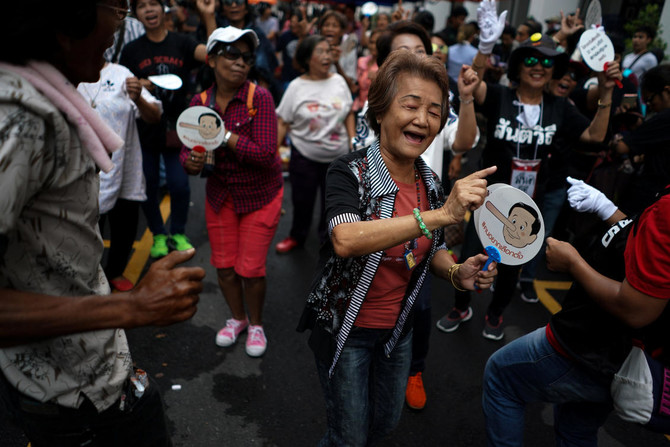
- Government House and surrounding streets have been declared a no-go zone by police for the opposition march marking four years since a May 22, 2014 coup
- The junta, known as the National Council for Peace and Order, is facing a public perception crisis
Polish officials condemn arson attack on Warsaw synagogue

A statement from the Jewish community in Warsaw expressed its “concern and indignation” at the attack
WARSAW: Polish authorities on Wednesday condemned an arson attack against a Warsaw synagogue.
Foreign Minister Radoslaw Sikorski, quoting the country’s chief rabbi, said “someone tried to set fire to the Nozyk synagogue with a Molotov cocktail.”
“Thank God no-one was hurt,” the minister added in a post on X, formerly Twitter.
“I condemn this shameful attack on the Nozyk synagogue in Warsaw,” Polish President Andrzej Duda wrote on X. “Anti-Semitism has no place in Poland. There is no place for hate in Poland.”
An AFP journalist at the scene saw a black stain across a window that appeared to have been caused by flames, but there was no major damage to the synagogue.
A statement from the Jewish community in Warsaw to AFP expressed its “concern and indignation” at the attack.
“Fortunately, the synagogue was empty at night and the material damage is minor,” it added.
The fire from the Molotov cocktail burned itself out outside the building, said the text, from Eliza Panek, vice president of the Jewish community in Warsaw.
“For the moment, we don’t know anything about the person or persons behind the attack, or their motives,” she added.
Warsaw police told AFP they “always take this kind of incident seriously” and the would do everything to ensure those responsible were punished.
So far, no one has claimed responsibility for the attack.
But Sikorski’s message speculated on who might have carried out the attack on the 20th anniversary of Poland’s membership of the European Union.
“Maybe the same ones who scrawled the Stars of David in Paris?” he said.
French prosecutors started an investigation after several dozen Jewish symbols were daubed on buildings in Paris in October as tensions increased amid Israel’s war against Hamas in Gaza.
France believes that Russian security services were behind the vandalism, an official French source said, but Russia has denied any involvement.
Saudi tourism launches first travel show in Indonesia

- Over 1.5 million Indonesians visited Saudi Arabia in 2023
- Saudi Tourism Authority exhibit in Jakarta runs until May 5
JAKARTA: The Saudi Tourism Authority launched on Wednesday its first show exhibition in Indonesia to introduce the Kingdom’s cultural and adventure destinations to visitors from the world’s largest Muslim-majority country.
The tourism sector has been booming under Vision 2030, as the Kingdom positions itself as a dynamic, diverse, year-round tourism destination and market that will contribute 10 percent to the gross domestic product by 2030.
Welcomed with dates and qahwa — traditional Arabic coffee — Indonesians flocked the STA exhibition inaugurated by Saudi Hajj and Umrah Minister Tawfiq Al-Rabiah and Alhasan Aldabbagh, STA president for Asia-Pacific markets, at the Kota Kasablanka Mall in South Jakarta.
“Saudi and Indonesia are good countries that have enjoyed social and economic ties for many, many years, and we have been receiving and welcoming many Indonesian travelers who are going for Umrah and Hajj,” Aldabbagh told reporters.
“We want to attract even more Indonesians, not just to do Umrah but to explore other places … Indonesia is a special market for us because of this strong relationship.”
More than 1.5 million Indonesians visited the Kingdom in 2023, but as most of them traveled for Umrah and focused on pilgrimage sites, Saudi authorities are hoping that they will begin to also explore the country’s rich history and heritage.
Aldabbagh was expecting about 10,000 visitors daily at the Jakarta exhibition, which will run until May 5.
“We want people to learn about all the attractions that we have in Saudi … to come with their families and enjoy and discover,” he said, giving as examples Jeddah and AlUla.

A historical city on the eastern shore of the Red Sea, Jeddah from the 7th century has been a major port for Indian Ocean trade routes and also the gateway for Muslim pilgrims to Makkah.
Featured on the UNESCO World Heritage List, Jeddah has a distinctive architectural tradition, with influences from along the ancient trade routes.
AlUla, another UNESCO site, is an ancient desert oasis and one of the most significant cultural cradles in the Arabian Peninsula.
The ancient kingdoms flourished in the AlUla Valley between 800 and 100 B.C. and were followed by Hegra — Saudi Arabia’s first location registered on the World Heritage List — was a major city of the Nabataean civilization whose capital, Petra, was located in present-day Jordan.
The Saudi travel show in Jakarta has already drawn interest from prospective visitors, who said they are intrigued by the variety of destinations the Kingdom had to offer.
“This is good for us to gain more information because we’ve never had this before, this is rare. Usually, we’ll get information from travel agencies, but this is coming straight from the Saudi authorities,” said Yudi Prasetyo, a Jakarta resident.
Another visitor, Linda Wardani, was curious to explore the Kingdom’s ancient sites, which she has so far known only from social media channels.
“We are curious to see AlUla looking so wonderful,” she said. “We are even more curious about other destinations in Saudi Arabia because when it comes to Umrah, the destinations are commonly known, but aside from that, we’re seeing the growth of Saudi Arabia and there are other tourist sites to see.”
Halid Umar Bakadam, CEO of Dream Tour travel agency, has also observed a growing interest beyond Umrah. His company now offers extended tours, where visitors can go and see other destinations in the Kingdom.
“They are welcoming more tourists,” he said. “For the new destinations, there are quite many people showing interest.”
Kenya flood toll rises to 179 as homes and roads are destroyed

- The death toll in Kenya exceeds that from flooding triggered by the El Nino weather phenomenon late last year
- Last year’s rains followed the worst drought in large parts of East Africa in decades
NAIROBI: Floods and landslides across Kenya have killed 179 people since March, with hundreds of thousands forced to leave their homes, the government said on Wednesday, as dozens more were killed in neighboring Tanzania and Burundi.
Torrential rain and floods have destroyed homes, roads, bridges and other infrastructure across the region. The death toll in Kenya exceeds that from flooding triggered by the El Nino weather phenomenon late last year.
Last year’s rains followed the worst drought in large parts of East Africa in decades.
In Kitengela, 33 km (20 miles) from Nairobi, Kenya Red Cross workers were helping to rescue residents whose homes were marooned by flood waters.
They were also trying to rescue tourists trapped at camps in Narok, 215 km from Nairobi, the Kenya Red Cross said on X.
Nairobi’s highways authority said it had closed a section of a highway leading to the city and at least three other roads across the country due to flooding and debris.
The disaster prompted Pope Francis to speak out in sympathy with Kenyans during a general audience on Wednesday at the Vatican.
“I ... wish to express to the people of Kenya my spiritual closeness at this time as severe flooding has tragically taken the lives of many of our brothers and sisters, injured others and caused widespread destruction,” he said.
More war debris in Gaza than Ukraine: UN

- UNMAS estimated the amount of debris in Gaza at 37 million tons in mid-April or 300 kilogrammes per square meter
- “Gaza has more rubble than Ukraine, and to put that in perspective, the Ukrainian front line is nearly 1,000 kilometers long, and Gaza is 40 km long,” said UNMAS’s head Mungo Birch
GENEVA: The Gaza Strip is filled with more war debris and rubble than Ukraine, the head of UN demining operations for the narrow Palestinian territory said Wednesday.
And the danger for clearance work is restricted not just to unexploded ordnance but includes possible exposure to toxic substances such as asbestos.
The United Nations Mine Action Service (UNMAS) estimated the amount of debris in Gaza at 37 million tons in mid-April, or 300 kilogrammes per square meter.
“Gaza has more rubble than Ukraine, and to put that in perspective, the Ukrainian front line is 600 miles (nearly 1,000 kilometers) long, and Gaza is 25 miles (40 km) long,” said Mungo Birch, head of the UNMAS program in the Palestinian territories.
But the sheer volume of rubble is not the only problem, said UNMAS.
“This rubble is likely heavily contaminated with UXO (unexploded ordnance), but its clearance will be further complicated by other hazards in the rubble,” Birch told journalists.
“There’s estimated to be over 800,000 tons of asbestos, for instance, alone in the Gaza rubble.” The cancer-causing mineral used in construction requires special precautions when handling.
Birch said he hoped UNMAS, which works to mitigate the threats posed by all types of explosive ordnance, would become the coordination body for mine action in Gaza.
It has secured $5 million of funding but needs a further $40 million to continue its work in Gaza over the next 12 months.
However, “the sector as a whole will need hundreds of millions of US dollars over multiple years in order to make Gaza safe again for the population,” Birch added.
The Gaza war started after Hamas’s October 7 attack on southern Israel, which resulted in the deaths of 1,170 people, mostly civilians, according to an AFP tally of Israeli official figures.
Israel’s retaliatory offensive has killed at least 34,568 people in Gaza, mostly women and children, according to the health ministry in the Hamas-run territory.
Philippines bets on wellness, medical tourism to attract Middle Eastern visitors

- Philippines wants position as a leading halal tourism destination
- Nation aims to welcome 7.7m international visitors in 2024
MANILA: The Philippine tourism sector is shifting to promote the country as a medical and wellness destination, expanding beyond its recreational profile to attract more visitors from the Middle East.
More than 2 million international travelers visited the Philippines since the beginning of the year, with receipts between January and April reaching $2.7 billion. This data, the Department of Tourism said last week, was a 120 percent recovery rate from the same period in 2019 — before COVID-19 lockdowns brought the industry to a standstill.
The department’s data also showed a 10 percent increase in visitors arriving from Gulf countries, especially Saudi Arabia and the UAE, which are among the Philippine government’s key emerging-market targets.
To further boost their arrivals and make the country a more attractive destination, tourism stakeholders are shifting their strategy to focus more on the wellness sector, Philippine Tour Operators Association President Arjun Shroff told Arab News.
“This strategic shift aims to position the Philippines as an emerging medical and wellness destination in Asia, expanding beyond its traditional recreational tourism offerings like beaches and diving spots,” he said.
Efforts have also been undertaken to expand the footprint of halal services and goods.
The predominantly Catholic Philippines — where Muslims constitute about 10 percent of the nearly 120 million population — plans to raise 230 billion pesos ($4 billion) in investments and generate around 120,000 jobs by expanding its domestic halal industry by 2028.
The cross-sector efforts include tourism as well, with the Philippines trying to position itself as a leading halal tourism destination.
“We have recently implemented a range of strategic initiatives to enhance our appeal to visitors from the Middle East. Central to our approach is a commitment to inclusivity, ensuring that all tourists feel welcome and safe,” Shroff said.
“In line with this commitment, we have actively promoted halal establishments to cater to the dietary preferences of Middle Eastern travelers. By offering a variety of halal dining options, we aim to provide a seamless and enjoyable culinary experience.”
Filipinos have been exposed to the Middle East, especially Gulf countries, which are home to some 2 million Philippine expats. They understand cultural differences and many also know Arabic.
The tourism sector has lately been tapping into Arabic-speaking talent to help facilitate tours for Middle Eastern travelers.
“We have invested in bilingual tour guides proficient in Arabic ... These guides play a vital role in facilitating communication, providing valuable insights, and enhancing the overall experience for our Middle Eastern guests,” Shroff said.
“Philippine travel and tourism agencies strategically target the Middle East market ... (it) holds great potential for the Philippines.”
In 2024, the Philippines is targeting to welcome 7.7 million international visitors, nearly its pre-pandemic record-breaking achievement in 2019 which ended with 8.26 million inbound arrivals.


